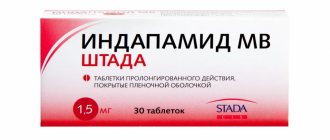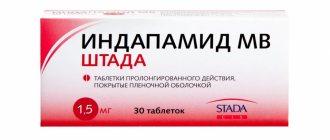Indapamide
Undesirable drug combinations
— Lithium preparations:
With the simultaneous use of indapamide and lithium preparations, as well as when following a salt-free diet, an increase in the concentration of lithium in the blood plasma may be observed due to a decrease in its excretion, accompanied by the appearance of signs of overdose. If necessary, diuretics can be used in combination with lithium preparations, and the lithium content in the blood plasma should be monitored and the dose of the drug should be adjusted accordingly.
Combinations of drugs requiring special attention
- Drugs that can cause aritis:
- class I A antiarrhythmic drugs (quinidine, hydroquinidine, disopyramide);
- class III antiarrhythmic drugs (amiodarone, sotalol, dofetilide, ibutilide);
- some neuroleptics: phenothiazines (chlorpromazine, cyamemazine, levomepromazine, thioridazine, trifluoroperazine), benzamides (amisulpride, sulpiride, sultopride, tiapride). butyrophenones (droperidol, haloperidol);
- others: bepridil, cisapride, difemanil, erythromycin (iv), halofantrine, mizolastine, pentamidine, sparfloxacin, moxifloxacin, vincamine (iv), astemizole.
Increased risk of developing ventricular arrhythmias, especially arrhythmias (hypokalemia is a risk factor).
It is necessary to determine the potassium content in the blood plasma and. if necessary, adjust it before starting combination therapy with indapamide and the above drugs. It is necessary to monitor the patient’s clinical condition, monitor the level of electrolytes in the blood plasma, and ECG indicators.
In patients with hypokalemia, drugs that do not cause ari should be used.
- Systemic nonsteroidal anti-inflammatory drugs, including selective cyclooxygenase-2 (COX-2) inhibitors, high doses of acetylsalicylic acid (≥ 3 g/day):
The antihypertensive effect of indapamide may be reduced. There is a risk of developing acute renal failure due to a decrease in glomerular filtration rate. Patients need to compensate for fluid loss and carefully monitor renal function at the beginning of therapy.
— Angiotensin-converting enzyme (ACE) inhibitors:
Prescribing ACE inhibitors to patients with low sodium levels in the blood (especially patients with renal artery stenosis) is accompanied by a risk of sudden arterial hypotension and/or acute renal failure.
Patients with arterial hypertension and, possibly, a decrease in the content of sodium ions in the blood plasma due to diuretics should:
- 3 days before starting therapy with an ACE inhibitor, stop taking the diuretic. In the future, if necessary, the diuretic can be resumed;
- or start ACE inhibitor therapy with low doses, followed by a gradual increase in dose if necessary.
In chronic heart failure, therapy with ACE inhibitors should be started with low doses, with a possible preliminary reduction in the doses of diuretics.
In all cases, in the first week of taking ACE inhibitors in patients, it is necessary to monitor renal function (plasma creatinine content).
- Other drugs that can cause hypokalemia: amphotericin B (iv), gluco- and mineralocorticosteroids for systemic use, tetracosactide, laxatives that stimulate intestinal motility:
Increased risk of hypokalemia (additive effect). Constant monitoring of potassium concentration in the blood plasma and, if necessary, its correction is necessary. It is recommended to use laxatives that do not stimulate intestinal motility.
- Baclofen:
There is an increase in the hypotensive effect. Patients need to compensate for fluid loss and carefully monitor renal function at the beginning of treatment.
— Cardiac glycosides:
Hypokalemia enhances the toxic effect of cardiac glycosides. With the simultaneous use of indapamide and cardiac glycosides, the content of potassium in the blood plasma, ECG parameters should be monitored and, if necessary, therapy should be adjusted.
Drug combinations requiring attention
— Potassium-sparing diuretics (amiloride, spironolactone, triamterene):
Combination therapy with indapamide and potassium-sparing diuretics is advisable in some patients, but the possibility of developing hypokalemia or hyperkalemia cannot be excluded (especially in patients with renal failure or in patients with diabetes mellitus).
It is necessary to monitor the potassium content in the blood plasma, ECG indicators and, if necessary, adjust therapy.
— Metformin:
Functional renal failure, which can occur against the background of diuretics, especially loop diuretics, with simultaneous administration of metformin increases the risk of developing lactic acidosis. Metformin should not be used if creatinine levels exceed 15 mg/L (135 µmol/L) in men and 12 mg/L (110 µmol/L) in women.
— Iodine-containing contrast agents:
In case of dehydration while taking diuretics, the risk of developing acute renal failure increases, especially when using high doses of iodine-containing contrast agents. Before using iodinated contrast agents, patients need to compensate for fluid loss.
— Tricyclic antidepressants, antipsychotics (neuroleptics):
Drugs in these classes enhance the antihypertensive effect of indapamide and increase the risk of orthostatic hypotension (additive effect).
— Calcium salts:
With simultaneous administration, hypercalcemia may develop due to a decrease in the excretion of calcium ions by the kidneys.
- Cyclosporine, tacrolimus:
It is possible to increase the creatinine content in the blood plasma without changing the concentration of circulating cyclosporine, even with normal fluid and sodium ion levels.
— Corticosteroid drugs, tetracosactide (for systemic use):
Reduced hypotensive effect (retention of fluid and sodium ions as a result of the action of corticosteroids).
Indapamide retard extended-release tablets 1.5 mg 30 pcs.
NOT RECOMMENDED COMBINATIONS. Lithium preparations. With the simultaneous use of indapamide and lithium preparations, an increase in the concentration of lithium in the blood plasma may be observed due to a decrease in its excretion, accompanied by the appearance of signs of overdose. If necessary, diuretic drugs can be prescribed in combination with lithium drugs, and the dose of the drugs should be carefully selected, constantly monitoring the lithium content in the blood plasma. COMBINATIONS REQUIRING SPECIAL CAUTION. Drugs that can cause arrhythmias: class IA antiarrhythmic drugs (quinidine, hydroquinidine, disopyramide); class III antiarrhythmic drugs (amiodarone, dofetilide, ibutilide), sotalol; some neuroleptics: phenothiazines (chlorpromazine, cyamemazine, levomepromazine, thioridazine, trifluoroperazine), benzamides (amisulpride, sulpiride, sultopride, tiapride), butyrophenones (droperidol, haloperidol); others: bepridil, cisapride, difemanil, erythromycin (iv), halofantrine, mizolastine, pentamidine, sparfloxacin, moxifloxacin, astemizole, vincamine (iv). Increased risk of ventricular arrhythmias, especially arrhythmias (risk factor - hypokalemia). The potassium level in the blood plasma should be determined and, if necessary, adjusted before starting combination therapy with indapamide and the above drugs. It is necessary to monitor the patient’s clinical condition, monitor the content of blood plasma electrolytes, and ECG indicators. Patients with hypokalemia should be prescribed drugs that do not cause aritis. Non-steroidal anti-inflammatory drugs (for systemic use), including selective cyclooxygenase-2 (COX-2) inhibitors, high doses of salicylates (? 3 g/day). The antihypertensive effect of indapamide may be reduced. With significant fluid loss, acute renal failure may develop (due to decreased glomerular filtration). Patients need to compensate for fluid loss and carefully monitor renal function at the beginning of treatment. Angiotensin-converting enzyme (ACE) inhibitors. The use of ACE inhibitors in patients with reduced levels of sodium ions in the blood (especially patients with renal artery stenosis) is accompanied by a risk of sudden arterial hypotension and/or acute renal failure. Patients with arterial hypertension and possibly reduced levels of sodium ions in the blood plasma as a result of taking diuretics should: stop taking diuretics 3 days before starting treatment with an ACE inhibitor. In the future, if necessary, diuretics can be resumed; or start ACE inhibitor therapy at low doses, followed by a gradual increase in dose, if necessary. In chronic heart failure, treatment with ACE inhibitors should begin with low doses with a possible preliminary reduction in the doses of diuretics. In all cases, in the first week of taking ACE inhibitors in patients, it is necessary to monitor renal function (plasma creatinine concentration). Other drugs that can cause hypokalemia: amphotericin B (iv), gluco- and mineralocorticosteroids (when used systemically), tetracosactide, laxatives that stimulate intestinal motility. Increased risk of hypokalemia (additive effect). Regular monitoring of potassium levels in the blood plasma is necessary, and correction if necessary. Particular attention should be paid to patients concomitantly receiving cardiac glycosides. It is recommended to use laxatives that do not stimulate intestinal motility. Baclofen. There is an increase in the hypotensive effect. Patients need to compensate for fluid loss and, at the beginning of treatment, carefully monitor renal function. Cardiac glycosides. Hypokalemia enhances the toxic effect of cardiac glycosides. With the simultaneous use of indapamide and cardiac glycosides, the content of potassium in the blood plasma, ECG parameters should be monitored, and, if necessary, therapy should be adjusted. COMBINATIONS OF DRUGS REQUIRING ATTENTION. Potassium-sparing diuretics (amiloride, spironolactone, triamterene). Combination therapy with indapamide and potassium-sparing diuretics is advisable in some patients, but the possibility of developing hypokalemia (especially in patients with diabetes mellitus and renal failure) or hyperkalemia cannot be excluded. It is necessary to monitor the potassium content in the blood plasma, ECG indicators and, if necessary, adjust therapy. Metformin. Functional renal failure, which can occur against the background of diuretics, especially loop diuretics, with simultaneous use of metformin increases the risk of developing lactic acidosis. Metformin should not be prescribed if the creatinine concentration exceeds 15 mg/L (135 µmol/L) in men and 12 mg/L (110 µmol/L) in women. Iodinated contrast agents. Dehydration while taking diuretics increases the risk of developing acute renal failure, especially when using high doses of iodinated contrast agents. Before using iodinated contrast agents, patients need to compensate for fluid loss. Tricyclic antidepressants, antipsychotics (neuroleptics). Drugs in these classes enhance the antihypertensive effect of indapamide and increase the risk of orthostatic hypotension (additive effect). Calcium salts. With simultaneous use, hypercalcemia may develop due to a decrease in the excretion of calcium ions by the kidneys. Cyclosporine, tacrolimus. It is possible to increase the concentration of creatinine in the blood plasma without changing the concentration of circulating cyclosporine, even with normal fluid and sodium ion levels. Corticosteroid drugs, tetracosactide (for systemic use). Reduced hypotensive effect (retention of fluid and sodium ions as a result of the action of corticosteroids).



